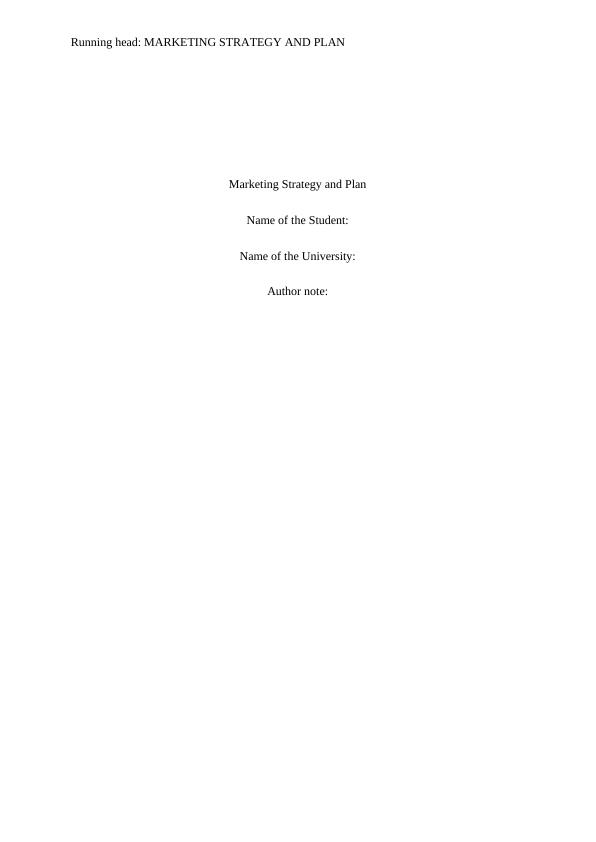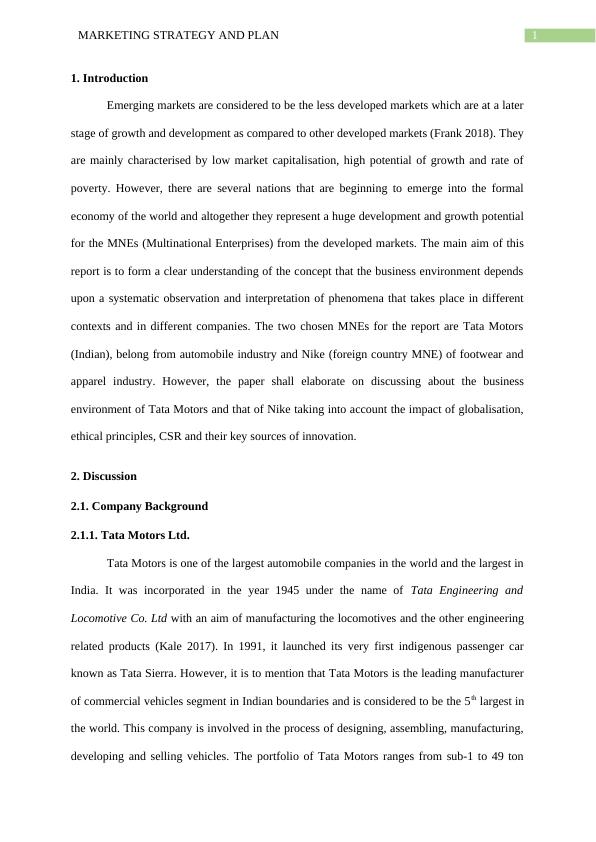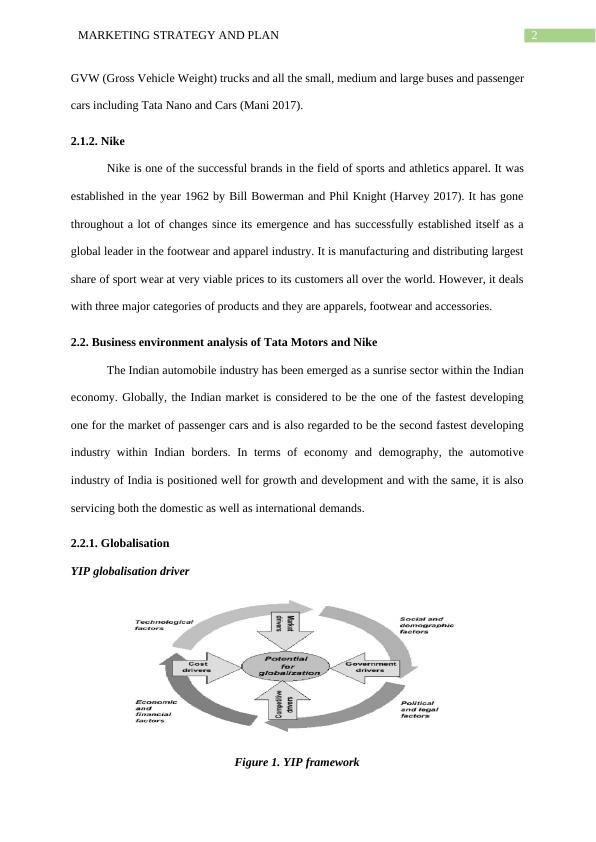Marketing Strategy and Plan
Added on 2023-04-21
14 Pages3953 Words460 Views
Running head: MARKETING STRATEGY AND PLAN
Marketing Strategy and Plan
Name of the Student:
Name of the University:
Author note:
Marketing Strategy and Plan
Name of the Student:
Name of the University:
Author note:

1MARKETING STRATEGY AND PLAN
1. Introduction
Emerging markets are considered to be the less developed markets which are at a later
stage of growth and development as compared to other developed markets (Frank 2018). They
are mainly characterised by low market capitalisation, high potential of growth and rate of
poverty. However, there are several nations that are beginning to emerge into the formal
economy of the world and altogether they represent a huge development and growth potential
for the MNEs (Multinational Enterprises) from the developed markets. The main aim of this
report is to form a clear understanding of the concept that the business environment depends
upon a systematic observation and interpretation of phenomena that takes place in different
contexts and in different companies. The two chosen MNEs for the report are Tata Motors
(Indian), belong from automobile industry and Nike (foreign country MNE) of footwear and
apparel industry. However, the paper shall elaborate on discussing about the business
environment of Tata Motors and that of Nike taking into account the impact of globalisation,
ethical principles, CSR and their key sources of innovation.
2. Discussion
2.1. Company Background
2.1.1. Tata Motors Ltd.
Tata Motors is one of the largest automobile companies in the world and the largest in
India. It was incorporated in the year 1945 under the name of Tata Engineering and
Locomotive Co. Ltd with an aim of manufacturing the locomotives and the other engineering
related products (Kale 2017). In 1991, it launched its very first indigenous passenger car
known as Tata Sierra. However, it is to mention that Tata Motors is the leading manufacturer
of commercial vehicles segment in Indian boundaries and is considered to be the 5th largest in
the world. This company is involved in the process of designing, assembling, manufacturing,
developing and selling vehicles. The portfolio of Tata Motors ranges from sub-1 to 49 ton
1. Introduction
Emerging markets are considered to be the less developed markets which are at a later
stage of growth and development as compared to other developed markets (Frank 2018). They
are mainly characterised by low market capitalisation, high potential of growth and rate of
poverty. However, there are several nations that are beginning to emerge into the formal
economy of the world and altogether they represent a huge development and growth potential
for the MNEs (Multinational Enterprises) from the developed markets. The main aim of this
report is to form a clear understanding of the concept that the business environment depends
upon a systematic observation and interpretation of phenomena that takes place in different
contexts and in different companies. The two chosen MNEs for the report are Tata Motors
(Indian), belong from automobile industry and Nike (foreign country MNE) of footwear and
apparel industry. However, the paper shall elaborate on discussing about the business
environment of Tata Motors and that of Nike taking into account the impact of globalisation,
ethical principles, CSR and their key sources of innovation.
2. Discussion
2.1. Company Background
2.1.1. Tata Motors Ltd.
Tata Motors is one of the largest automobile companies in the world and the largest in
India. It was incorporated in the year 1945 under the name of Tata Engineering and
Locomotive Co. Ltd with an aim of manufacturing the locomotives and the other engineering
related products (Kale 2017). In 1991, it launched its very first indigenous passenger car
known as Tata Sierra. However, it is to mention that Tata Motors is the leading manufacturer
of commercial vehicles segment in Indian boundaries and is considered to be the 5th largest in
the world. This company is involved in the process of designing, assembling, manufacturing,
developing and selling vehicles. The portfolio of Tata Motors ranges from sub-1 to 49 ton

2MARKETING STRATEGY AND PLAN
GVW (Gross Vehicle Weight) trucks and all the small, medium and large buses and passenger
cars including Tata Nano and Cars (Mani 2017).
2.1.2. Nike
Nike is one of the successful brands in the field of sports and athletics apparel. It was
established in the year 1962 by Bill Bowerman and Phil Knight (Harvey 2017). It has gone
throughout a lot of changes since its emergence and has successfully established itself as a
global leader in the footwear and apparel industry. It is manufacturing and distributing largest
share of sport wear at very viable prices to its customers all over the world. However, it deals
with three major categories of products and they are apparels, footwear and accessories.
2.2. Business environment analysis of Tata Motors and Nike
The Indian automobile industry has been emerged as a sunrise sector within the Indian
economy. Globally, the Indian market is considered to be the one of the fastest developing
one for the market of passenger cars and is also regarded to be the second fastest developing
industry within Indian borders. In terms of economy and demography, the automotive
industry of India is positioned well for growth and development and with the same, it is also
servicing both the domestic as well as international demands.
2.2.1. Globalisation
YIP globalisation driver
Figure 1. YIP framework
GVW (Gross Vehicle Weight) trucks and all the small, medium and large buses and passenger
cars including Tata Nano and Cars (Mani 2017).
2.1.2. Nike
Nike is one of the successful brands in the field of sports and athletics apparel. It was
established in the year 1962 by Bill Bowerman and Phil Knight (Harvey 2017). It has gone
throughout a lot of changes since its emergence and has successfully established itself as a
global leader in the footwear and apparel industry. It is manufacturing and distributing largest
share of sport wear at very viable prices to its customers all over the world. However, it deals
with three major categories of products and they are apparels, footwear and accessories.
2.2. Business environment analysis of Tata Motors and Nike
The Indian automobile industry has been emerged as a sunrise sector within the Indian
economy. Globally, the Indian market is considered to be the one of the fastest developing
one for the market of passenger cars and is also regarded to be the second fastest developing
industry within Indian borders. In terms of economy and demography, the automotive
industry of India is positioned well for growth and development and with the same, it is also
servicing both the domestic as well as international demands.
2.2.1. Globalisation
YIP globalisation driver
Figure 1. YIP framework

3MARKETING STRATEGY AND PLAN
It is to note that the YIP globalisation driver depends upon a total of four different drivers
and they are Market globalisation drivers, Government globalisation drivers, Cost
globalisation drivers and Competitive globalisation drivers (Figure 1. Framework of YIP).
Tata Motors (automobile industry)
a) Government Globalisation drivers- Governments have imposed very strict regulations
on the issue of dealing with the emission control and the fuel economy on the
automobile manufacturers all over the world. Notwithstanding this fact, maximum of
the automobile manufacturers agree with the fact that the environmental regulations
would provide advantage to the industry because more number of money would be
invested in the task of promotion of the new generation motor vehicles. For Tata
Motors, the main drivers of government globalisation are the trade policies such as the
Mutual Recognition and the elimination of all the tariff and the non-tariff barriers are
significant barrier of trade policies (Dawar and Arora 2016). With the same, in India
the technical standards are compatible for overall all the industries and the customers
that are government owned lose their potential to favour the national or domestic
suppliers. Also, there is increasing number of middle class families in India.
b) Market globalisation drivers- Some of the significant market drivers for the
automobile industry in India are the common customer needs and the transferable
marketing. The significant market globalisation drivers for Tata Motors are that the
needs of the customers in contemporary world has become more common (Sarin
2018). Their needs in relation to the automotive industry are increasing the tendency
of globalisation. Customers prefer to select the vehicles on the basis of reliability,
price, and quality and with the same, the climate, culture and the patriotic base also
influence the needs of the customers. In India, people are prone to showcase their
social status and they often make use of luxurious and big cars. With the same, there is
It is to note that the YIP globalisation driver depends upon a total of four different drivers
and they are Market globalisation drivers, Government globalisation drivers, Cost
globalisation drivers and Competitive globalisation drivers (Figure 1. Framework of YIP).
Tata Motors (automobile industry)
a) Government Globalisation drivers- Governments have imposed very strict regulations
on the issue of dealing with the emission control and the fuel economy on the
automobile manufacturers all over the world. Notwithstanding this fact, maximum of
the automobile manufacturers agree with the fact that the environmental regulations
would provide advantage to the industry because more number of money would be
invested in the task of promotion of the new generation motor vehicles. For Tata
Motors, the main drivers of government globalisation are the trade policies such as the
Mutual Recognition and the elimination of all the tariff and the non-tariff barriers are
significant barrier of trade policies (Dawar and Arora 2016). With the same, in India
the technical standards are compatible for overall all the industries and the customers
that are government owned lose their potential to favour the national or domestic
suppliers. Also, there is increasing number of middle class families in India.
b) Market globalisation drivers- Some of the significant market drivers for the
automobile industry in India are the common customer needs and the transferable
marketing. The significant market globalisation drivers for Tata Motors are that the
needs of the customers in contemporary world has become more common (Sarin
2018). Their needs in relation to the automotive industry are increasing the tendency
of globalisation. Customers prefer to select the vehicles on the basis of reliability,
price, and quality and with the same, the climate, culture and the patriotic base also
influence the needs of the customers. In India, people are prone to showcase their
social status and they often make use of luxurious and big cars. With the same, there is

End of preview
Want to access all the pages? Upload your documents or become a member.
Related Documents
Strategic Management in Tata Motorslg...
|16
|3470
|42
Business Environment of Tata Motorslg...
|17
|2682
|91
Report: Business of Tata Motorslg...
|8
|2933
|43
Indian Automobile Industry: Overview, Market Structure, Competition, and Supply Chainlg...
|15
|3020
|64
Contemporary Marketing Strategies for Tata Motors: SWOT Analysis, Competitor Analysis, and Budget Planninglg...
|14
|1085
|388
Market Analysis of Tata Motors: Economic Characteristics and Key Success Factorslg...
|12
|2463
|381